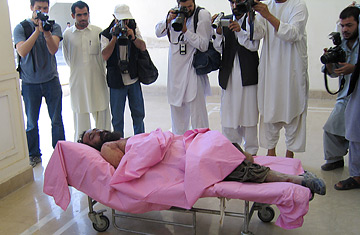
Afghan journalists photograph the dead body of the Taliban's top military commander, Mullah Dadullah, in Kandahar, May 13, 2007.
Replacing Dadullah won't be easy for the Taliban, in part because his own brutality may have eliminated a number of potential successors. "He killed the guys above him, so quite a lot of capable or respected leaders have disappeared in his move up the ranks of the Taliban," says a Western Intelligence official in southern Afghanistan. A possible successor, Ahktar Mohammed Osmani, was killed in December in an air strike. Another, Obaidullah Akhund, was captured in February. But it remains to be seen whether Dadullah's death will herald a breakdown of the Taliban's command-and-control structure, or inspire his followers to avenge him and close ranks by intensifying their own deadly efforts.
Over the past five years, Dadullah has emerged as the top operational commander of the Taliban resistance, uniting his fighters with a combination of charismatic media spin and a penchant for barbarism. He is thought to have organized the growing wave of suicide bombings in Afghanistan, and to have commanded over a dozen beheadings, videos of which showing terrified Afghan prisoners circulated in bazaars and were sent to the country's television stations.
His appearance in the governor's mansion in Kandahar under a pink sheet, a wound on his head and his naked torso bloodied by two injuries, certainly dealt a psychological blow to the Taliban, for whom Dadullah has emerged as a powerful propaganda rallying point. His persona was used to recruit new fighters by the Taliban, with leaflets distributed only last week in Zabul province urging former mujahedin who had fought the Soviets in the 1980s to rally behind him. After losing a leg as a young mujaheed in the anti-Soviet jihad, Dadullah rose through the ranks of the Taliban, becoming a member of its 10-man leadership council. His death, therefore, makes him the highest-profile Taliban leader to be killed since the U.S.-led invasion in 2001.
He had been a key figure, over the past two years, in uniting a rag-tag mix of indigent opium farmers, hardened Islamic fighters and bandits into an effective insurgency that has stretched NATO's resources. "After the fall of the Taliban, all the Taliban escaped to different areas, and he was the only one to marshal them and bring them together as a cohesive force," says Waheed Mujda, author of a number of books about the Taliban.>
Afghan Defense Ministry spokesman Mohammed Zaher Azimi said Dadullah's death, in the southern province of Helmand, could open a schism between rival Taliban commanders in the south and prompt defections from less committed fighters. "I think Dadullah's death will affect enemy ranks. We know he was the key Taliban figure who had the ability to center the Taliban efforts under a central command," he said.
The precise details of his death remain unclear. NATO said he was killed during U.S.-led operations when he "left his sanctuary into southern Afghanistan." Intelligence officials said he was killed in the southern province of Helmand. But it remained uncertain whether Dadullah had been killed by an air strike or in ground combat, Western military officials said.
Still, nobody's expecting that taking Dadullah out of the picture is going to end the sting of the Taliban — any more than the killing of Musab al-Zarqawi did in the case of the Iraq insurgency. A Taliban spokesman on Monday hailed Dadullah as a martyr, announcing that his brother had been appointed to take his place. "This is not going to slow down the Taliban jihad," spokesman Yousuf Ahmadi said by telephone reading a statement attributed to the movement's fugitive leader, Mullah Mohammad Omar. That remains to be proved in the field, but the Iraq experience has conditioned Western officials to lower expectations arising from the elimination of even key insurgent leaders.
